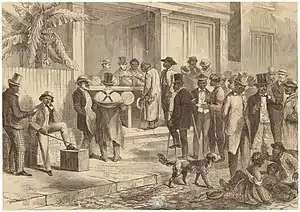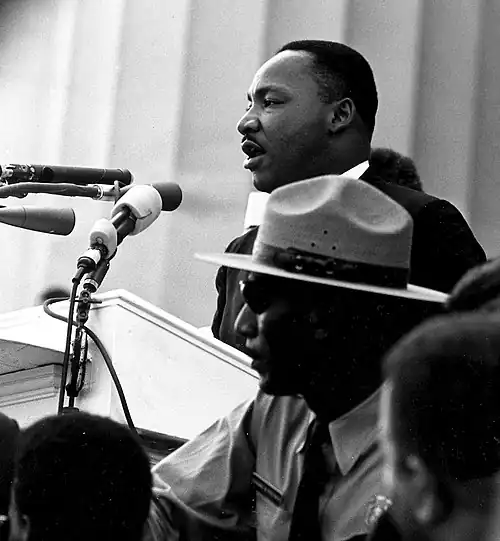Portal:Civil rights movement
The civil rights movement portal_-_NARA_-_542010.jpg.webp) The 1963 March on Washington participants and leaders marching from the Washington Monument to the Lincoln Memorial
The civil rights movement was a nonviolent social movement and campaign from 1954 to 1968 in the United States to abolish legalized racial segregation, discrimination, and disenfranchisement throughout the United States. The movement had its origins in the Reconstruction era during the late 19th century, although it made its largest legislative gains in the 1960s after years of direct actions and grassroots protests. The social movement's major nonviolent resistance and civil disobedience campaigns eventually secured new protections in federal law for the civil rights of all Americans. After the American Civil War and the subsequent abolition of slavery in the 1860s, the Reconstruction Amendments to the United States Constitution granted emancipation and constitutional rights of citizenship to all African Americans, most of whom had recently been enslaved. For a short period of time, African-American men voted and held political office, but as time went on they were increasingly deprived of civil rights, often under the racist Jim Crow laws, and African Americans were subjected to discrimination and sustained violence by white supremacists in the South. Over the following century, various efforts were made by African Americans to secure their legal and civil rights, such as the civil rights movement (1865–1896) and the civil rights movement (1896–1954). The movement was characterized by nonviolent mass protests and civil disobedience following highly publicized events such as the lynching of Emmett Till. These included boycotts such as the Montgomery bus boycott, "sit-ins" in Greensboro and Nashville, a series of protests during the Birmingham campaign, and a march from Selma to Montgomery. At the culmination of a legal strategy pursued by African Americans, in 1954 the Supreme Court struck down many of the laws that had allowed racial segregation and discrimination to be legal in the United States as unconstitutional. The Warren Court made a series of landmark rulings against racist discrimination, including the separate but equal doctrine, such as Brown v. Board of Education (1954), Heart of Atlanta Motel, Inc. v. United States (1964), and Loving v. Virginia (1967) which banned segregation in public schools and public accommodations, and struck down all state laws banning interracial marriage. The rulings played a crucial role in bringing an end to the segregationist Jim Crow laws prevalent in the Southern states. In the 1960s, moderates in the movement worked with the United States Congress to achieve the passage of several significant pieces of federal legislation that authorized oversight and enforcement of civil rights laws. The Civil Rights Act of 1964 explicitly banned all discrimination based on race, including racial segregation in schools, businesses, and in public accommodations. The Voting Rights Act of 1965 restored and protected voting rights by authorizing federal oversight of registration and elections in areas with historic under-representation of minority voters. The Fair Housing Act of 1968 banned discrimination in the sale or rental of housing. (Full article...) Selected article -
The sit-in movement, sit-in campaign or student sit-in movement, were a wave of sit-ins that followed the Greensboro sit-ins on February 1, 1960 in North Carolina. The sit-in movement employed the tactic of nonviolent direct action and was a pivotal event during the Civil Rights Movement. African-American college students attending historically Black colleges and universities in the United States powered the sit-in movement across the country. Many students across the country followed by example, as sit-ins provided a powerful tool for students to use to attract attention. The students of Baltimore made use of this in 1960 where many used the efforts to desegregate department store restaurants, which proved to be successful lasting about three weeks. This was one small role Baltimore played in the civil rights movement of the 1960s. The city facilitated social movements across the country as it saw bus and taxi companies hiring African-Americans in 1951–1952. Students at Baltimore, Maryland's, Morgan State College had successfully deployed sit-ins and other direct action protest tactics against lunch counters in that city since at least 1953. The local chapter of the Congress of Racial Equality had had similar success. Witnessing the unprecedented visibility afforded in the white-oriented mainstream media to the 1960 sit-ins in Greensboro, North Carolina, Morgan students (and others, including those from the Johns Hopkins University) continued sit-in campaigns already underway at department store restaurants near their campus. There were massive amounts of support from the community for the students’ efforts, but more importantly, white involvement and support grew in favor of desegregation of department store restaurants. (Full article...)General imagesThe following are images from various civil rights movement-related articles on Wikipedia.
Related portalsWikiProjects
Selected biography -
Mary Jane McLeod Bethune (née McLeod; July 10, 1875 – May 18, 1955) was an American educator, philanthropist, humanitarian, womanist, and civil rights activist. Bethune founded the National Council of Negro Women in 1935, established the organization's flagship journal Aframerican Women's Journal, and presided as president or leader for a myriad of African American women's organizations including the National Association for Colored Women and the National Youth Administration's Negro Division. She also was appointed as a national adviser to president Franklin D. Roosevelt, whom she worked with to create the Federal Council on Colored Affairs, also known as the Black Cabinet. She is well-known for starting a private school for African-American students in Daytona Beach, Florida. It later continued to develop as Bethune-Cookman University. (Full article...)Selected image - Missing persons poster created by the FBI in 1964, signed by the Director J. Edgar Hoover. Shows the photographs of Andrew Goodman, James Chaney, and Michael Schwerner. All three were found to have been later murdered by local White Knights of the Ku Klux Klan, and the Neshoba County Sheriff's Office as well as the Philadelphia, Mississippi Police Department were involved in the incident. Did you know?
TopicsSubcategoriesCategory puzzle Select [►] to view subcategories
Civil rights movement People involved with the civil rights movement Black Panther Party Civil rights movement case law Civil rights movement in popular culture Martin Luther King Jr. Little Rock Nine Montgomery bus boycott Monuments and memorials of the civil rights movement Civil rights movement museums Nashville Student Movement Selma to Montgomery marches Southern Conference Educational Fund Student Nonviolent Coordinating Committee Students for a Democratic Society Works about the civil rights movement Civil rights movement stubs Select [►] to view subcategories
WikiProject Civil Rights Movement WikiProject Civil Rights Movement articles Civil Rights Movement articles by importance Civil Rights Movement articles by quality Civil Rights Movement portal WikiProject Civil Rights Movement participants Things to doAssociated WikimediaThe following Wikimedia Foundation sister projects provide more on this subject:
Discover Wikipedia using portals
| ||||||
.jpg.webp)








.jpg.webp)

_-_NARA_-_542019.jpg.webp)
.jpg.webp)


_-_NARA_-_542056.jpg.webp)






_-_NARA_-_542018.jpg.webp)




.jpg.webp)
_(cropped).jpg.webp)
